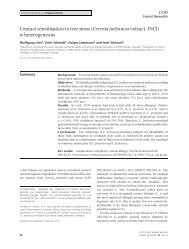703. INDIGOFERA HOWELLII Brian Schrire, Susyn Andrews and ...
703. INDIGOFERA HOWELLII Brian Schrire, Susyn Andrews and ...
703. INDIGOFERA HOWELLII Brian Schrire, Susyn Andrews and ...
You also want an ePaper? Increase the reach of your titles
YUMPU automatically turns print PDFs into web optimized ePapers that Google loves.
Howell <strong>and</strong> Forrest became good friends <strong>and</strong> on the third Expedition<br />
(1912–1915), Howell supervised two of Forrest’s collectors who were<br />
left behind to collect in <strong>and</strong> around the Tengyueh area; he also<br />
provided a room to dry their specimens (McLean, 2004).<br />
On the fourth Expedition (1917–1920), Forrest collected F.14880<br />
(K!) in fruit during September 1917 on the Mekong-Salween Divide,<br />
at Lat. 28 ◦ 12 ′ N, between 3048 <strong>and</strong> 3353 m. This 1.2–2.7 m shrub<br />
was growing in open scrub <strong>and</strong> pine forests. It has been variously<br />
identified as Indigofera sp., I. pendula or I. galegoides DC. but is in<br />
fact I. howellii. There were eight major sponsors for this particular<br />
expedition, one of whom was Reginald Cory. Seeds of F.14880 were<br />
distributed from the Royal Horticultural Society’s (RHS) garden at<br />
Wisley as A72 <strong>and</strong> A687 (Forrest, 1929). Plants grown from F.14880<br />
went to the National Botanic Gardens, Glasnevin in Dublin, where a<br />
specimen was collected from the Iris Border Wall on September 21,<br />
1937 (DBN!), as well as to the Arnold Arboretum, Boston. Glasnevin’s<br />
material had come from Cory <strong>and</strong> a plant was still alive in 1984, S.<br />
<strong>Andrews</strong> s.n. (K!). Alfred Rehder had collected specimens at the Arnold<br />
in August 1920 (K!).<br />
In the United States, other specimens of Indigofera howellii had been<br />
collected by Rehder in 1925, 1928 <strong>and</strong> 1929 (A!) at the Arnold. Seed<br />
had been sent from RBG Edinburgh (no. 18234) in the early 1920s<br />
<strong>and</strong> identified as I. wardiana, an unpublished name. In Cowan (1952),<br />
the author made no mention of any of the above collections when<br />
discussing the various Indigofera species that Forrest had collected.<br />
Reginald Cory (1871–1934) was a director of Cory Brothers,<br />
who owned colliery, shipping <strong>and</strong> oil firms. He inherited Dyffryn, a<br />
magnificent estate in the Vale of Glamorgan, outside Cardiff, from<br />
his father <strong>and</strong> according to the l<strong>and</strong>scape architect Thomas Mawson<br />
was regarded ‘as an amateur l<strong>and</strong>scape gardener <strong>and</strong> horticulturist<br />
of insight <strong>and</strong> ability.’ At Dyffryn, Cory planted out trees <strong>and</strong> shrubs<br />
grown from expeditions that he had helped to finance, e.g. to China<br />
<strong>and</strong> other countries, including four of the seven George Forrest<br />
expeditions (Elliott, 1998; McLean, 2004; Day, 2006).<br />
Following Cory’s death in 1934, there was an unfortunate period<br />
when many plants were sold before the house <strong>and</strong> gardens were<br />
© The Board of Trustees of the Royal Botanic Gardens, Kew 2011. 81



